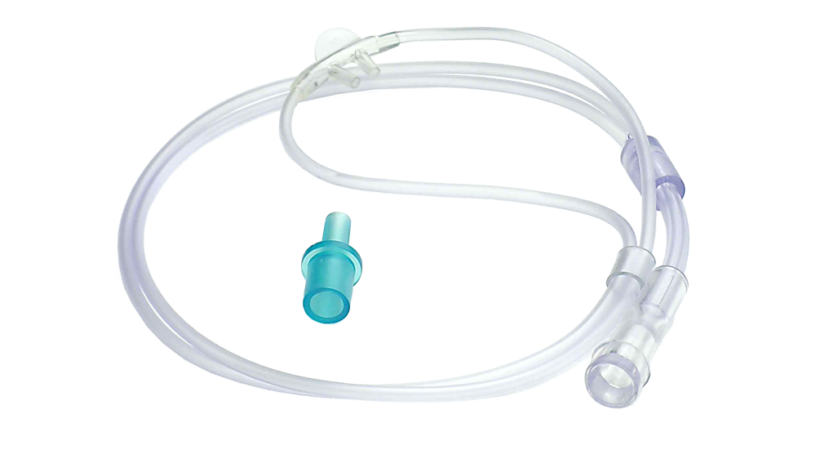The high-flow nasal cannula (HFNC) market involves the development, production, and distribution of medical devices designed to deliver high-flow rates of oxygen through a nasal cannula to patients in need of respiratory support. HFNC systems are increasingly used in various clinical settings, including hospitals, outpatient clinics, and home healthcare, due to their effectiveness in treating patients with respiratory conditions, such as chronic obstructive pulmonary disease (COPD), pneumonia, and COVID-19.
Overview: High-flow nasal cannula therapy provides a higher flow of oxygen compared to standard oxygen therapy, often delivering humidified and heated oxygen, which improves patient comfort and outcomes. The market for HFNC devices has expanded significantly, especially during the COVID-19 pandemic, due to the increased demand for non-invasive respiratory support.
Market Size and Growth: The HFNC market has seen substantial growth due to the rising prevalence of respiratory diseases, the aging population, and the increased need for effective respiratory therapies. The market is further driven by advancements in HFNC technology, greater adoption in clinical practice, and increased awareness of the benefits of HFNC therapy among healthcare professionals. The global market is expected to continue its growth trajectory, fueled by ongoing innovation and expanding applications of HFNC systems.
Trends:
- Technological Advancements:
- Development of more advanced HFNC devices with features such as precise flow control, integrated monitoring systems, and improved humidification capabilities.
- Introduction of portable and user-friendly HFNC devices for home healthcare settings, enhancing patient mobility and quality of life.
- Increased Adoption in Clinical Practice:
- Growing acceptance and use of HFNC therapy in various clinical scenarios, including emergency departments, intensive care units (ICUs), and post-operative care, due to its effectiveness and ease of use.
- COVID-19 Impact:
- The COVID-19 pandemic has significantly increased the demand for HFNC devices as a preferred non-invasive respiratory support option for patients with severe respiratory distress.
- Integration with Digital Health:
- Integration of HFNC systems with digital health platforms for remote monitoring and management of patients, improving treatment adherence and outcomes.
- Focus on Patient Comfort:
- Enhanced focus on improving patient comfort with the development of HFNC devices that offer better humidification and temperature control, reducing nasal dryness and irritation.
Challenges:
- High Costs:
- The relatively high cost of advanced HFNC systems can be a barrier to adoption, particularly in low- and middle-income countries.
- Training and Expertise:
- Proper use of HFNC therapy requires training and expertise, which can be a limiting factor in some healthcare settings.
- Infrastructure Requirements:
- HFNC systems often require specific infrastructure, such as access to electrical power and medical-grade oxygen, which may not be available in all healthcare facilities.
- Complications and Side Effects:
- Potential complications and side effects, such as nasal dryness, discomfort, and, in rare cases, barotrauma, necessitate careful monitoring and management.
- Regulatory Hurdles:
- Navigating complex regulatory environments and gaining approval for new HFNC devices can be time-consuming and costly.
Market Drivers:
- Rising Prevalence of Respiratory Diseases:
- Increasing prevalence of respiratory conditions such as COPD, asthma, and acute respiratory distress syndrome (ARDS) is driving the demand for effective respiratory support therapies like HFNC.
- Aging Population:
- The aging global population, which is more susceptible to respiratory issues, is contributing to the growing demand for HFNC therapy.
- Advancements in Medical Technology:
- Continuous advancements in medical technology are leading to the development of more effective and user-friendly HFNC devices, boosting market growth.
Click Here, To Get Free Sample Report https://stringentdatalytics.com/sample-request/high-flow-nasal-cannula-market/16501/
Market Segmentations:
Global High-flow Nasal Cannula Market: By Company
Fisher & Paykel Healthcare
ResMed
Teijin Pharma
Becton Dickinson
MEK-ICS
Teleflex
Smiths Medical
Vapotherm
Flexicare
Salter Labs
Hamilton Medical
TNI medical
Great Group
Global High-flow Nasal Cannula Market: By Type
Air/Oxygen Blender
Active Humidifier
Single Heated Tube
Nasal Cannulas
Others
Global High-flow Nasal Cannula Market: By Application
Hospitals
Long-term Care Centers
Ambulatory Care Centers
Others
Global High-flow Nasal Cannula Market: Regional Analysis
The regional analysis of the global High-flow Nasal Cannula market provides insights into the market’s performance across different regions of the world. The analysis is based on recent and future trends and includes market forecast for the prediction period. The countries covered in the regional analysis of the High-flow Nasal Cannula market report are as follows:
North America: The North America region includes the U.S., Canada, and Mexico. The U.S. is the largest market for Cold-chain Pharma in this region, followed by Canada and Mexico. The market growth in this region is primarily driven by the presence of key market players and the increasing demand for the product.
Europe: The Europe region includes Germany, France, U.K., Russia, Italy, Spain, Turkey, Netherlands, Switzerland, Belgium, and Rest of Europe. Germany is the largest market for Cold-chain Pharma in this region, followed by the U.K. and France. The market growth in this region is driven by the increasing demand for the product in the automotive and aerospace sectors.
Asia-Pacific: The Asia-Pacific region includes Singapore, Malaysia, Australia, Thailand, Indonesia, Philippines, China, Japan, India, South Korea, and Rest of Asia-Pacific. China is the largest market for Cold-chain Pharma in this region, followed by Japan and India. The market growth in this region is driven by the increasing adoption of the product in various end-use industries, such as automotive, aerospace, and construction.
Middle East and Africa: The Middle East and Africa region includes Saudi Arabia, U.A.E, South Africa, Egypt, Israel, and Rest of Middle East and Africa. The market growth in this region is driven by the increasing demand for the product in the aerospace and defense sectors.
South America: The South America region includes Argentina, Brazil, and Rest of South America. Brazil is the largest market for Cold-chain Pharma in this region, followed by Argentina. The market growth in this region is primarily driven by the increasing demand for the product in the automotive sector.
Click Here, To Buy Premium Report https://stringentdatalytics.com/purchase/high-flow-nasal-cannula-market/16501/?license=single
About Stringent Datalytics
Stringent Datalytics offers both custom and syndicated market research reports. Custom market research reports are tailored to a specific client’s needs and requirements. These reports provide unique insights into a particular industry or market segment and can help businesses make informed decisions about their strategies and operations.
Syndicated market research reports, on the other hand, are pre-existing reports that are available for purchase by multiple clients. These reports are often produced on a regular basis, such as annually or quarterly, and cover a broad range of industries and market segments. Syndicated reports provide clients with insights into industry trends, market sizes, and competitive landscapes. By offering both custom and syndicated reports, Stringent Datalytics can provide clients with a range of market research solutions that can be customized to their specific needs.
Contact Us
Stringent Datalytics
Contact No- +1 346 666 6655
Email Id- sales@stringentdatalytics.com
Web- https://stringentdatalytics.com/




Leave a Reply